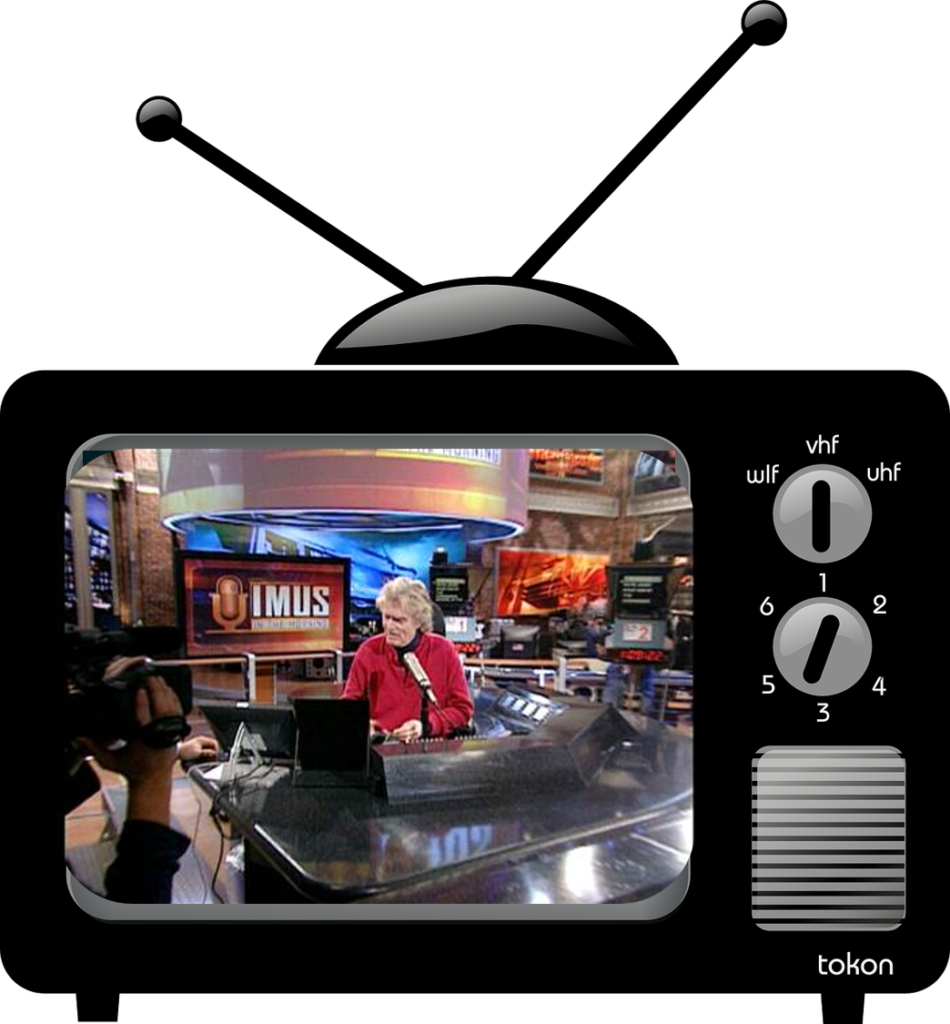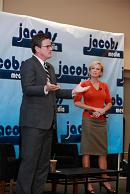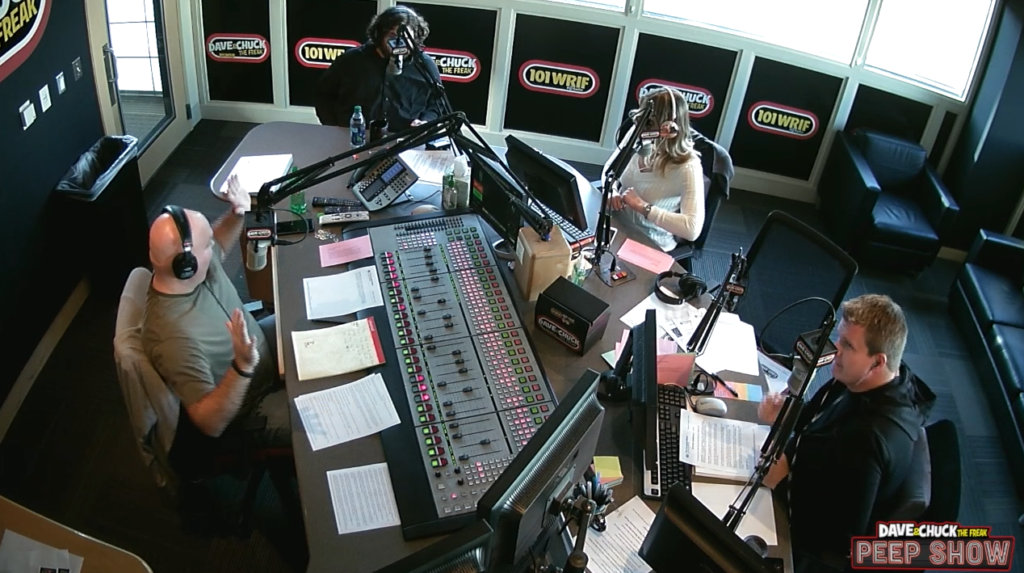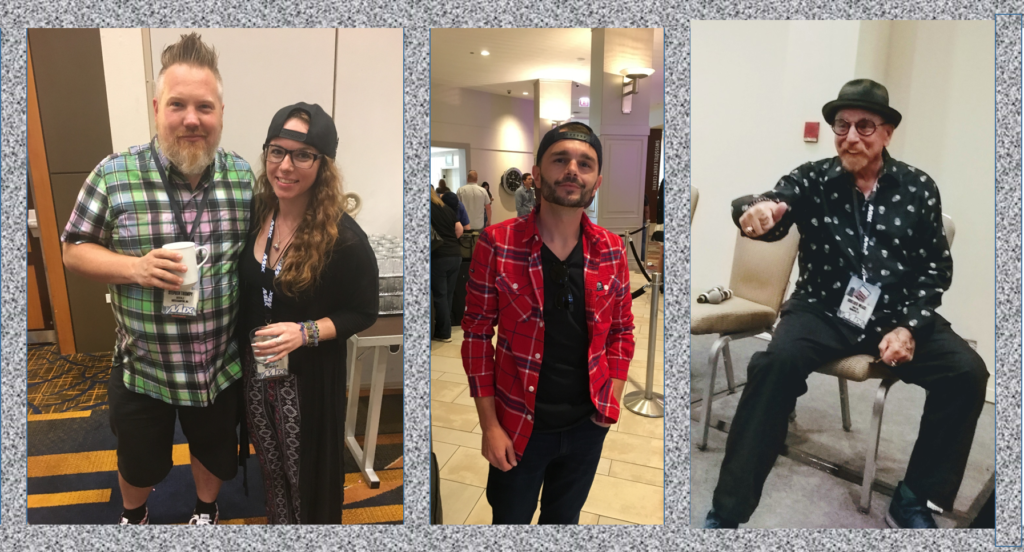
You’re forgiven if you missed an important radio anniversary during the short week following the Labor Day holiday. While you were busily working on your plan for the remainder of 2019, a key milestone in radio and TV came and went:
The debut of “Imus In The Morning” on MSNBC in 1996
As radio historians know, Imus was the wildly successful morning guy on WFAN in New York, resurrecting a checkered, controversial career. On the Fan, Imus combined his ironic humor, character voices, along with real famous guests from sports, showbiz, and especially politics. And it was this last piece that truly resonated with listeners. Because unlike seeing these big names on shows like “Meet the Press,” the disarming Imus made them more comfortable, giving his audience insight into who these people really were.
Imus ran afoul of NBC in 2007 because of his controversial comments about the Rutgers’ women’s basketball team, ending a successful 11-year run of his morning show broadcast on cable TV. For MSNBC, the incident turned to lemonade when one of the rotating morning shows vying to replace Imus turned out to be “Morning Joe,” featuring Joe Scarborough and Mika Brzezinski, still going strong, especially in our overheated political environment.
As a radio guy, I was fascinated by Imus on TV from day one. First, the studio looked very sexy. But most intriguing was seeing radio come alive every morning – talent cueing each other, the eye contact, hand signals, and the reactions on Imus’ face to pretty much everything he was hearing and seeing as the show progressed.
At first, I thought the appeal of seeing a big-time radio show every morning on television was merely interesting to people in the radio business. But over time, I realized my fascination was shared by many, especially those getting their first glance at the sheer entertainment value of getting that “backstage” look at how radio works, what Imus and his cast actually looked like, how the show was produced and how it flowed each weekday morning.
 “Morning Joe” became the next iteration of a morning show on MSNBC, incorporating many of the Imus lessons while innovating many of the characteristics of ensemble radio teams. We were fortunate to grab Joe and Mika for our Jacobs Summit in Philly back in 2009. And of course our vision was to give radio programmers and air talent the chance to see how the medium translates to television, while holding on to its morning radio essence.
“Morning Joe” became the next iteration of a morning show on MSNBC, incorporating many of the Imus lessons while innovating many of the characteristics of ensemble radio teams. We were fortunate to grab Joe and Mika for our Jacobs Summit in Philly back in 2009. And of course our vision was to give radio programmers and air talent the chance to see how the medium translates to television, while holding on to its morning radio essence.
And now other television hosts are working out of what look a lot like radio studios – CNBC’s Jim Cramer’s “Mad Money” is a great example.
His show mimics a radio studio (note the “ON-AIR” sign), as well as a sound effects board Cramer uses to accentuate points or play with callers  over the phone. In many way, Cramer looks and sounds like a financial “shock jock,” arms waving, shouting, ranting, and raving. No doubt about it – “Mad Money” has a very radio-esque look.
over the phone. In many way, Cramer looks and sounds like a financial “shock jock,” arms waving, shouting, ranting, and raving. No doubt about it – “Mad Money” has a very radio-esque look.
And then there are all the “morning shows on TV,” whether network productions like “Today” and “GMA” or the myriad “Good Morning, Des Moines” shows that dominate television during the hours that were once the sole province of radio.
And yet, most radio personalities are gun-shy about their appearance, as well as the value of having cameras in the studio. We have seen this the past couple years in our AQ study with the “I have a face for radio” agree/disagree statement.
While it’s a tongue-in-cheek question, the fact is, 28% of our respondents (men more than women) agree or agree strongly about their appearance not being ready for prime time. In all fairness to Don Imus or Howard Stern, I think it has nothing to do with looks, and everything to do with curiosity, content, and performance.
Perhaps this is also an offshoot of the reality that video cameras have systematically made their way into many radio stations these past few years.  Techsurvey data continues to remind us that radio listeners are far more likely to stream video than audio. And video cameras, as well as skilled producers and editors have made their way into many clusters all over the country.
Techsurvey data continues to remind us that radio listeners are far more likely to stream video than audio. And video cameras, as well as skilled producers and editors have made their way into many clusters all over the country.
So, why not go a step further? When I look at some of the impressive download data I’ve seen for daily morning show videos, like the type WMMR’s Preston & Steve (“Daily Rush”) and WRIF’s Dave & Chuck the Freak (“Peep Show”) post every weekday, I have to wonder why more shows aren’t following suit.
There’s nothing especially complicated – just a few cameras in the studio, capturing one of the show’s best moments each morning. And because the entire show is recorded, it begs the question why some haven’t gone the Imus/MSNBC route of providing streaming on on-demand video for the entire show.
And I was encouraged while roaming the halls and attending sessions at the Swisôtel in Chicago last month at Don Anthony’s 31st annual Morning Show Boot Camp. I couldn’t help but notice how well put together many radio personalities are. Here we were at the industry’s conference of on-air talent, and by and large, attendees were not only well-dressed, but many sported a calculated “look.”
Whether it was the “Breakfast Club” from Power 105.1 in NYC, where the “Women’s Forum” where the entire group looked camera-ready, or just on-air people and producers hanging out at Boot Camp, it was impossible not to notice how good everyone looked, and why radio personalities are becoming increasingly cognizant of not just how they sound but how they appear.

At a time when broadcast radio is in need of an update to its traditional recipe, the visual, behind-the-scenes side of radio could change the game for fans and advertisers. It has become less about being a passive listener, and more about experiences – something that’s well within the capability of most radio stations and many of its leading personalities. And let’s not forget the matter of product placement.
This is especially true for so-called daypart personalities, often limited in their ability to show their emotions or humor because of limited time. Now, they have a stage with which to
Yes, it requires a different level of preparation, new skills, and a focus on different aspects of performance an entertainment. But to be continue to be a relevant part of people’s lives and routines, radio may have to reinvent its presence. Video is a powerful tool that only MTV and Vh1 had.
Until now.
Sorry, James Cridland. No lazy Buggles references here to “video saved the radio star.”
But it may, in fact, come true.
- Media And Technology In 2025: Believe It Or Not! - April 18, 2025
- In Radio, You Just Never Know - April 17, 2025
- The Secret To Making A Great Podcast (And Great Radio) - April 16, 2025




Good read today, Fred. It’s worth stressing the value a radio show provides a TV partner. A camera-feed of a radio show provides cheap (inexpensive not un-valued) programming for the television outlet. Talk and sports radio gets it. Check out ESPN, Fox Sports, NBCSN and CBS Sports on cable/sat. Those daytime line-ups are filled with radio simulcasts.
We, radio, already have the content. Partnering with TV gives them something to show that’s way better than infomercials while we get further reach and exposure.
Eric, good points all. Thanks for the reminders & taking thee time to comment.
“There’s nothing especially complicated – just a few cameras in the studio, capturing one of the show’s best moments each morning.”
Fred, your post was forwarded from a friend.
Oh Fred.
Oh Fred, it’s not radio with “just a few cameras in the studio,” it’s TV then. And it IS complicated. And it should be if it’s going to be compelling.
I lost my 38 year career in local TV broadcasting to Multiple Myeloma, a very nasty cancer. Five bones fractured in a year and a half. I’ve got a titanium rod in my left shin bone. It’s the break that ended my career. Yes. Cancer does suck. But I am still passionate about broadcasting… television AND radio. It’s still about CONTENT. Good radio and TV journalists and on-air talent know that. But in television, even good journalists are now being crunched on by consultants to create “circus TV.” Take a look at most TV station Facebook pages.
TV is hard. Only sales and management use the EASY word. They’ve never done it (well), or if they had, they wouldn’t use the EASY word.
Radio is hard. But when it is done exceptionally well, it’s unforgettable. But adding “cameras” into the mix, without having experienced people using them to add to the drama of live radio, you just water down the message.
If every new camera shot doesn’t give my eye new information, it’s worthless. That’s TV 101.
If every new sentence doesn’t give my ear new information, it’s worthless. That’s Radio 101.
Radio in the hands of experts takes our minds to places television can not go. Radio is the continuation of the oral tradition that has nurtured civilization for thousands of years. Radio doesn’t need cameras bolted in various places around the studio to do what radio can do.
But I have seen entertaining radio matched with video. Their secret was a dedicated duo of TV professionals creating the video part of the content, while a number of radio announcers who also worked in television (and knew what good TV should look like), did their thing at the microphones. A pure form of orchestrated comedy. And when it broke down, it was entertaining watching the professionals pull it back together. It all worked because of the experienced people involved.
Norm
Norm, thanks for checking in. Sorry to hear about those health problems, but thrilled to hear you’re still very much in the game.
I did not mean to convey the “solution” is to purchase a couple security cameras and a switcher and call it good. Whether we’re talking TV, radio, or the Yellow Pages, it’s all about the creative.
I do believe, however, that between reality TV and YouTube, our sensibilities have changed. The content, of course, is still paramount. We must be moved in some way by what we’re listening to/watching no matter the medium.
But in the case of truly great shows like the ones I referenced, a voyeuristic look at what is really happening in the air studio is producing results – lots of interest and shocking numbers of page views. Could these productions (and now, I’m thinking about those short videos stations are creating) be better? And would a more polished or dramatic or comedic approach yield more success? Probably so.
In our current environment, most stations (including many major market properties) are having to cobble together basic solution to complex problems – like how to have a viable video presence. Some have stepped up, especially with the reliance of staffers who have experience producing and editing video, and are making good stuff. I’m just trying to encourage more experimentation. Many of these productions aren’t sponsored nor is there much riding on them. That’s the perfect sandbox in which to innovate.
I appreciate the passion and I respect where you’re coming from. Please keep reading our blog and commenting. And feel good.
It has been nearly a decade since 98 Rock put cameras in the studio. The early static shots have been replaced with a Tricaster and an employee acting as a switcher/video editor/website contributor. The live streams offer lots of sales opportunities from everything from banner ads to in-house commercials featuring talent that play before the stream starts. A few things about the set up will keep many stations these days from doing this and it all boils down to money and staffing. Yes compelling content will keep listeners “tuned in”, but the quality of the stream can be just as important to boost numbers. We have four high end cameras that are remotely controlled plus can zoom and swivel in the studio which gives a better representation of the show and a TV quality to the stream. So much so that our morning show is now on our sister TV station following Saturday Night Live. Management is now streaming our afternoon show as well with an automated system for the cameras that will give different views depending on who is talking. Another big cost is the actual stream itself. At one point we streamed all day but that lasted about two months until we got the bill from the service provider. As a female jock I am uncomfortable being on a studio cam because the perverts come out and say some really gross and inappropriate stuff through our text line or bolder still on the phone. The former Mid Day jock also complained of this. I can appreciate that studio cams are a great sales tool, draw for listeners to go to the website and a new outlet for personalities to be creative in promoting the station. However, the whole radio on TV concept still has to be compelling to watch, thoughtfully produced and should never be more important than the actual radio show.
Good thoughts all, Amelia. You raise some key points, concerns, and issues. This is not an easy nor is it a cheap undertaking. But coordinated with sales and the airstaff, it is where things are moving. Regarding the issues you raise as a female personality, I’m sympathetic. But TV talent has been dealing with the same issues sine the advent of that medium. It is the station’s/commpany’s responsibility to protect you, provide phone answering support, etc.
We’re living at a time when people are emboldened to do jerky or even heinous things. Haters gonna hate. It is unfortunate, but a fact of life. I still believe that in the end, this is an opportunity for some radio stations and some of their top personalities. Appreciate the comment.
Thanks for the shout out, Fred!
Here’s a nice quote from Trevor Horn (behind the song Video Killed The Radio Star):
“Video did not kill the radio star. Maybe he had him down for a couple of minutes but he came back up again swinging and he’s still healthy.”
🙂 Thanks for giving me something to write about!
Hello Fred, I love your blog and live webinars – –
As a pro working in many arenas radio, filmmaking, video/television production, and post-production, I am aligned with you, and believe that radio is a visual medium – as an air personality, you paint the image/visuals for the listening audience, so take it to the next level with streaming video, live FB broadcasts, on demand video, YouTube and other social media outlets to promote and market the brand in another layer of the broadcast onion.
And, as with making a movie, it’s all about the story, and not the EQUIPMENT –
Remember the old adage: If it ain’t on the page, it ain’t on the stage.
For those in this industry that claim they are “storytellers” then toss the dice, tell your radio broadcasting stories via live streaming video or on demand video, because either way, you’re creating content and expanding the audience.
However, you must remember beyond the story, it has to be good and with stellar production value – sometimes simple is better too.
Mark Anthony Besozzi
Producer | Director | Cameraman | Writer | On-Air Personality | VO Artist
Mark, good reminders all. I have not wanted to give the impression regarding video that “good enough” is good enough. To build and maintain and audience, it has to be strong content from valued personalities and have production values that (at the very least) don’t get in the way of the show. This IS about expanding the brand and the audience, as well as creating much-needed attention for a medium that is rarely marketed off its own air. Thanks for chiming in.
So where now do we go with the age-old joke, “Yes, I can see you were born with a face for radio!”
I would like to know how people react to seeing “regular joes” as opposed to well made-up, beautiful people used by television stations…
Does it enhance, or destroy, the experience?
Gerry
.
Gerry, maybe it’s a lot like MTV videos. Some make songs come alive; others ruin the magic behind the music. I prefer to not see these things as “good or bad,” but they are what we are. And while my generation may not be 100% on board, the next one is more excitable when it comes to seeing radio come alive before their eyes. Thanks for the insightful comment/question.